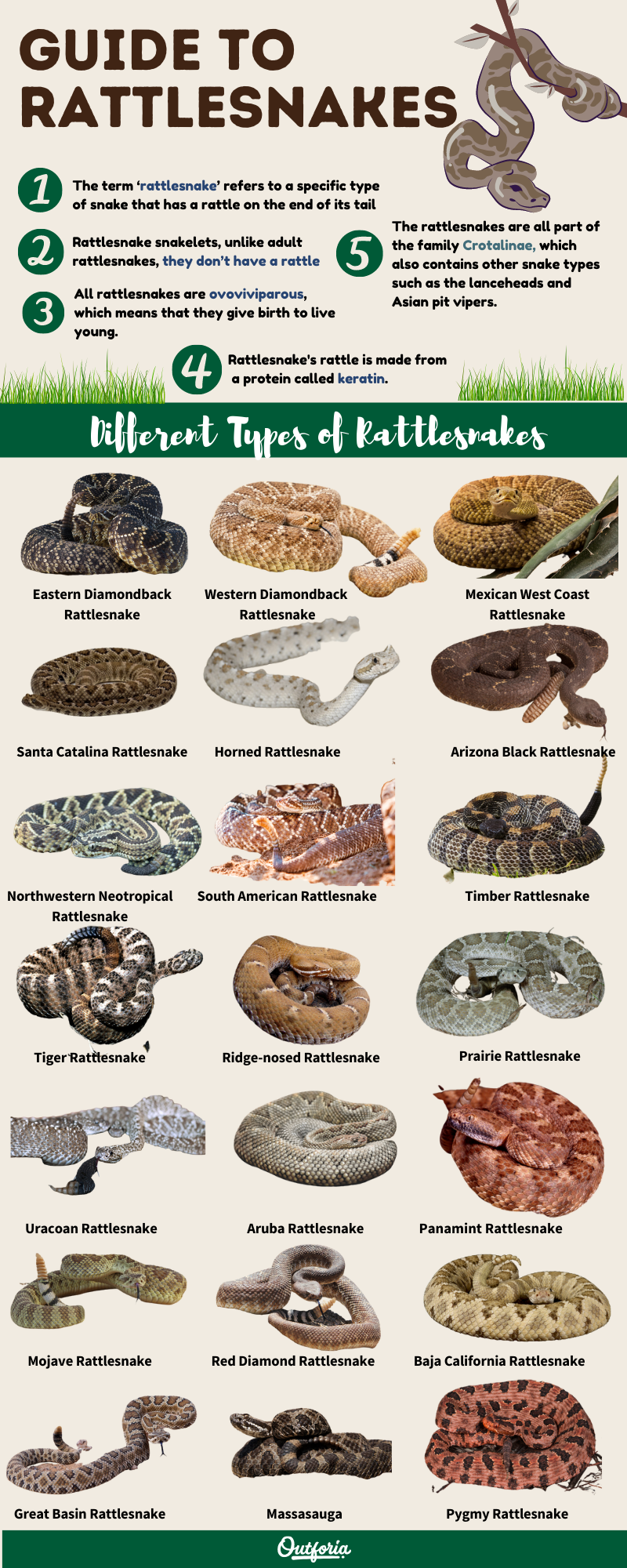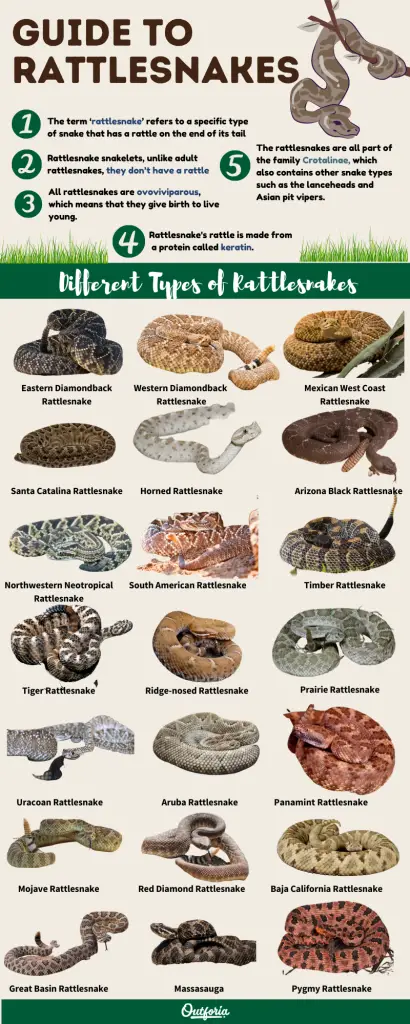Rattlesnakes are one of the most feared and fascinating creatures in the world. These venomous snakes have long been the subject of myths, legends, and Hollywood movies. But did you know that there are actually many different kinds of rattlesnakes out there?
From the deserts of the American Southwest to the rainforests of South America, rattlesnakes can be found in a wide variety of habitats. Some are small and docile, while others are large and aggressive. In this article, we’ll explore the different types of rattlesnakes and learn more about these fascinating reptiles. So, let’s get started!
There are over 30 different species of rattlesnakes, each with its own unique characteristics and distribution range. Some of the most common species include the Western Diamondback, Eastern Diamondback, Timber, Sidewinder, and Mojave rattlesnakes. Each species varies in size, coloration, and venom potency, making it important to be able to identify them in the wild.

How Many Different Kinds of Rattlesnakes Are There?
Rattlesnakes are a fascinating group of snakes that have been around for millions of years. They are known for their distinctive rattle on the end of their tail, which they use as a warning signal to potential predators. But how many different kinds of rattlesnakes are there? Let’s take a closer look.
1. Western Diamondback Rattlesnake
The Western Diamondback Rattlesnake is one of the most common and well-known rattlesnakes in North America. It can be found throughout the southwestern United States and parts of northern Mexico. This species is known for its large size and distinctive diamond-shaped markings on its back.
The Western Diamondback Rattlesnake is a venomous species, and its bite can be extremely dangerous. However, it is also an important part of the ecosystem, controlling populations of rodents and other small animals.
2. Eastern Diamondback Rattlesnake
The Eastern Diamondback Rattlesnake is the largest venomous snake in North America, and one of the most dangerous. It can be found in the southeastern United States, from North Carolina to Florida and west to Louisiana.
This species is known for its large size and distinctive diamond-shaped markings on its back. It is also known for its potent venom, which can be deadly to humans.
3. Sidewinder Rattlesnake
The Sidewinder Rattlesnake is a small species of rattlesnake that is found in the deserts of southwestern United States and northern Mexico. It is known for its unusual method of movement, in which it moves sideways across the sand.
This species is not as dangerous as some of the larger rattlesnakes, but its venom can still be dangerous to humans. It is an important part of the desert ecosystem, feeding on rodents and other small animals.
4. Timber Rattlesnake
The Timber Rattlesnake is a large species of rattlesnake that is found in the eastern United States, from Minnesota to Texas and east to the Atlantic Coast. It is known for its distinctive black and brown markings and its loud, buzzing rattle.
This species is venomous, but its venom is not as potent as some of the other rattlesnakes. It is an important predator in the forest ecosystem, feeding on rodents and other small animals.
5. Mojave Rattlesnake
The Mojave Rattlesnake is a venomous species of rattlesnake that is found in the southwestern United States and northern Mexico. It is known for its powerful venom, which can cause serious health problems in humans.
This species is also known for its distinctive black and white markings and its large size. It is an important predator in the desert ecosystem, feeding on rodents and other small animals.
6. Prairie Rattlesnake
The Prairie Rattlesnake is a medium-sized species of rattlesnake that is found in the central United States and parts of Canada. It is known for its distinctive brown and green markings and its loud, buzzing rattle.
This species is venomous, but its venom is not as potent as some of the other rattlesnakes. It is an important predator in the grassland ecosystem, feeding on rodents and other small animals.
7. Massasauga Rattlesnake
The Massasauga Rattlesnake is a small species of rattlesnake that is found in the central United States and parts of Canada. It is known for its distinctive gray and brown markings and its small size.
This species is venomous, but its venom is not as potent as some of the other rattlesnakes. It is an important predator in the wetland ecosystem, feeding on rodents and other small animals.
8. Western Rattlesnake
The Western Rattlesnake is a medium-sized species of rattlesnake that is found in the western United States and parts of Canada. It is known for its distinctive brown and green markings and its loud, buzzing rattle.
This species is venomous, but its venom is not as potent as some of the other rattlesnakes. It is an important predator in the forest and grassland ecosystems, feeding on rodents and other small animals.
9. Speckled Rattlesnake
The Speckled Rattlesnake is a small species of rattlesnake that is found in the southwestern United States and northern Mexico. It is known for its distinctive brown and gray markings and its small size.
This species is venomous, but its venom is not as potent as some of the other rattlesnakes. It is an important predator in the desert ecosystem, feeding on rodents and other small animals.
10. Black-tailed Rattlesnake
The Black-tailed Rattlesnake is a medium-sized species of rattlesnake that is found in the western United States and parts of Canada. It is known for its distinctive black and brown markings and its loud, buzzing rattle.
This species is venomous, but its venom is not as potent as some of the other rattlesnakes. It is an important predator in the forest and grassland ecosystems, feeding on rodents and other small animals.
In conclusion, there are many different kinds of rattlesnakes, each with its own unique characteristics and role in the ecosystem. While these snakes can be dangerous to humans, they are an important part of the natural world and should be respected and protected.
Frequently Asked Questions
Find below some of the most frequently asked questions about rattlesnakes and their different kinds.
What Are Rattlesnakes?
Rattlesnakes are venomous snakes that belong to the family Viperidae. They are characterized by the presence of a rattle at the end of their tails, which is composed of interlocking segments made of keratin. When the snake vibrates its tail, the segments rattle against each other and produce a buzzing sound that serves as a warning to potential predators or threats.
There are around 36 different species of rattlesnakes that are distributed across North and South America. These snakes can vary in size, color, pattern, and behavior, but they all share common traits, such as venomous fangs, heat-sensing pits, and a triangular-shaped head.
Where Do Rattlesnakes Live?
Rattlesnakes can be found in a variety of habitats, including deserts, forests, grasslands, swamps, and mountains. They are most common in the western hemisphere, particularly in the United States, Mexico, and South America. Some species of rattlesnakes are adapted to living in arid environments, while others prefer humid or tropical regions.
Depending on the species, rattlesnakes may be arboreal, terrestrial, or semi-aquatic. They can also be found at different elevations, ranging from sea level to high mountain tops. Some of the most common species of rattlesnakes in the United States include the Western Diamondback, the Timber Rattlesnake, the Mojave Rattlesnake, and the Eastern Diamondback.
Are Rattlesnakes Dangerous?
Yes, rattlesnakes are considered highly dangerous due to their venomous bites. Their venom can cause a range of symptoms, including pain, swelling, nausea, vomiting, dizziness, and even death in severe cases. It is important to avoid provoking or handling rattlesnakes, as they may attack if they feel threatened or cornered.
If you encounter a rattlesnake in the wild, it is best to keep a safe distance and give it plenty of space to move away. If you are bitten by a rattlesnake, seek medical attention immediately and try to remain calm and still to slow down the spread of venom in your body.
What Do Rattlesnakes Eat?
Rattlesnakes are carnivorous and feed on a variety of prey, including rodents, lizards, birds, and other snakes. They use their venomous fangs to immobilize their prey and then swallow it whole. Rattlesnakes have a unique way of digesting their food, as they can unhinge their jaws to accommodate larger prey and have a highly acidic stomach that can dissolve bones and other tough materials.
Some species of rattlesnakes have specialized diets, such as the Sidewinder Rattlesnake, which feeds on desert-dwelling kangaroo rats, or the Bushmaster, which preys on small mammals and birds in the Amazon rainforest.
Are Rattlesnakes Protected?
Yes, many species of rattlesnakes are protected by law in the United States and other countries where they are found. This is due to their important ecological role as predators and their vulnerability to habitat loss, poaching, and other human activities. It is illegal to kill, capture, or sell rattlesnakes without a permit, and penalties for violating these laws can be severe.
Some conservation groups work to educate the public about the importance of rattlesnakes and to promote habitat conservation and sustainable management practices that benefit both snakes and humans.
All Rattlesnake species / types of Rattlesnake / rattle snake
In conclusion, the rattlesnake is a fascinating creature that has captured the attention of many people. There are over 30 different species of rattlesnakes, each with its own unique features and characteristics. From the iconic western diamondback to the elusive sidewinder, these snakes have adapted to a wide range of habitats and environments.
Despite their reputation as dangerous predators, rattlesnakes play an important role in their ecosystems, controlling rodent populations and serving as prey for larger animals. However, it’s important to remember that these snakes should be respected and treated with caution. If you encounter a rattlesnake in the wild, it’s best to keep your distance and let it go about its business.
In conclusion, learning about the different kinds of rattlesnakes is not only interesting, but it also helps us appreciate the diversity of life on our planet. Whether you’re a wildlife enthusiast or just curious about these fascinating creatures, there’s always something new to discover about the world of rattlesnakes.


